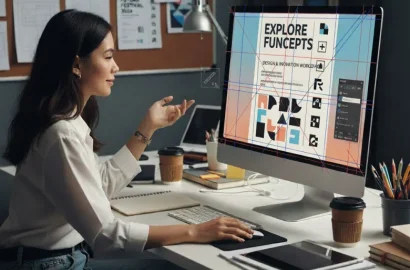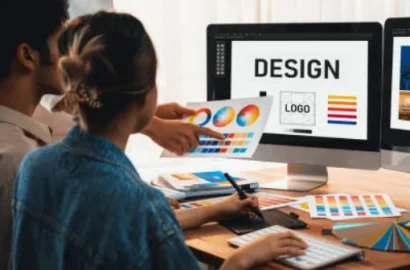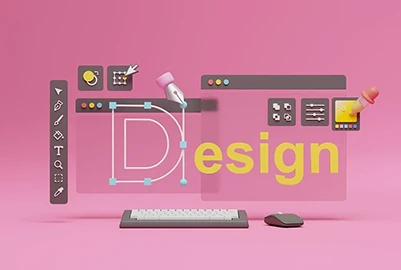A graphic design internship is a great way to learn on-the-job skills and break into the industry. Learn how to secure a graphic design internship, and why it’s beneficial, in this guide.
One of the biggest challenges that new designers face is gaining the practical experience required to land a job.
Even if you’ve obtained a graphic design qualification and built a solid portfolio, many employers prefer you to have some first-hand experience working in/with a design team in a real-world setting. A graphic design internship enables you to gain this experience and hone your skills, boosting your employability and increasing your chances of landing a full-time role.
In this guide, you’ll find everything you need to know about getting a graphic design internship, including:
- 1) What is a graphic design internship?
- 2) The benefits of a graphic design internship
- 3) Things to consider before doing a graphic design internship
- 4) How to get a graphic design internship
- 5) How to make the most of your graphic design internship
- 6) Taking the next step in your graphic design career
Let’s begin!
1. What is a graphic design internship?
A graphic design internship is a short-term, entry-level role for new graphic designers looking to gain real-world experience. Internships typically last between a few weeks and a few months—sometimes up to six months—and they can be paid or unpaid. It all depends on the company.
The goal of a graphic design internship is to provide first-hand exposure to the industry, allowing novice designers to hone their skills and learn from experienced professionals in the field.
An internship may lead to a long-term role within the same company, and, at the very least, will set you in good stead to land your first graphic design role elsewhere.
2. The benefits of a graphic design internship
The ultimate goal of a graphic design internship is to boost your employability and set you up for a full-time role in the field. An internship is a great opportunity to:
- Gain practical, on-the-job experience
- Learn more about your own interests and aspirations
- Add to your graphic design portfolio
- Develop essential soft skills
- Find a mentor
- Expand your graphic design network
Let’s take a closer look.
Gain practical, on-the-job experience
Even if you’ve obtained a graphic design qualification and completed practical design projects, there are many things you won’t learn until you’re actually working in the field.
With an internship, you’ll gain first-hand insight into how graphic designers work within a company or agency—including the processes they follow, how they manage different projects, and how they collaborate with different departments and stakeholders.
This on-the-job experience is crucial for understanding the inner workings of a career in graphic design. It’ll also leave you better equipped to land your first permanent role.
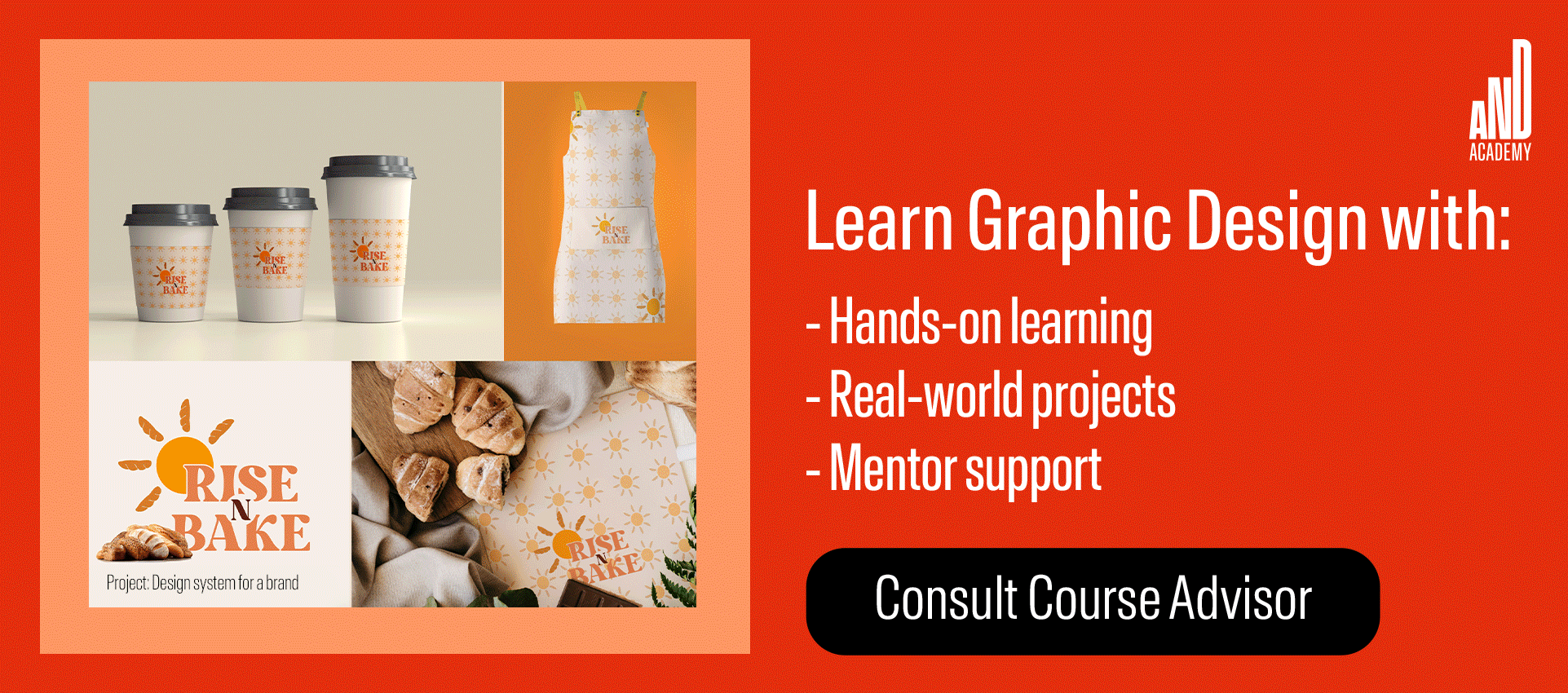
Learn more about your own interests and aspirations
Graphic design is a vast and varied field with many different career paths and job titles. If you’ve not yet worked as a graphic designer, it’s difficult to know exactly what kind of role you want and where you’d like to specialise.
A graphic design internship enables you to learn more about where your interests and strengths lie. This will help you to identify your career goals and determine what kind of roles you’ll apply for next.
You can learn more about different graphic design jobs (and their salaries) in this guide.
Add to your graphic design portfolio
A graphic design portfolio is essential for getting hired. It showcases your skills and demonstrates that you’re qualified to work in the field. But, if you’re a novice graphic designer, it can be difficult to find opportunities to work on real projects that you can include in your portfolio.
A graphic design internship will give you access to such opportunities, having you manage your own design projects or support senior graphic designers with theirs. This will help you flesh out your portfolio and, in turn, make it easier to convince hiring managers of your skills.
Develop essential soft skills
If you consider all the different skills a graphic designer needs , you’ll find that soft skills are critical. Graphic designers must be able to communicate and collaborate effectively, give and receive feedback, conduct thorough research, problem-solve, and pay close attention to detail.
While a graphic design course will teach you technical, job-specific hard skills, soft skills are usually developed in the field. As part of your graphic design internship, you’ll work closely with others and hone those key soft skills—another big tick when it comes to impressing hiring managers and landing your first job.
Find a mentor
Mentorship is incredibly valuable throughout your graphic design career, especially when you’re just starting out. A good mentor can provide feedback, advice, and general wisdom and support as you navigate your new career.
You may be assigned a mentor as part of your graphic design internship, or you might establish a mentor-mentee relationship organically while working in a design team. Either way, an internship will connect you with experienced graphic designers who you can observe, ask questions, and learn from.
Expand your graphic design network
Networking is essential in any career, and graphic design is no exception. A strong industry network increases your exposure to job opportunities and gives you an important sense of community within your new field.
Often, all you need is an “in”—one contact in the field will soon lead to another. With a graphic design internship, you’ll naturally make those first connections and start to build your network.

3. Things to consider before doing a graphic design internship
There’s plenty to gain from a graphic design internship. But, given that internships tend to be either completely unpaid or relatively low-paid, it’s important to consider whether or not this is a feasible and worthwhile route.
Before you pursue a graphic design internship, here are some questions to ask yourself.
Is a graphic design internship financially viable?
Internships aren’t known for their high salaries. Many internships are unpaid, while others might offer a low salary or stipend. At the same time, you may be required to give up a paid job or reduce your hours in order to complete a graphic design internship. So, the first factor to consider is whether or not you have the financial means to make it work.
Do I have time to complete an internship?
Finances aside, how does an internship fit in with your current schedule and existing commitments? If you’re employed, will it be possible to take time out, and for how long?
A graphic design internship is ideal if you’re between jobs, but it may be tricky to juggle if you’re currently in employment. Think about how much time you could realistically commit to an internship and plan accordingly.
Does a graphic design internship align with my career goals?
Last but not least, consider whether a graphic design internship will provide value at this point in your career. If you’re an entry-level graphic designer and need real-world experience in order to land your first job, an internship is a great stepping stone.
But, if you’re completely new to graphic design and haven’t yet learned the fundamentals, you’re likely not in a position to get the most value out of an internship just yet. Consider taking a graphic design course before seeking to gain practical, on-the-job experience.
Ultimately, assess whether an internship is feasible in terms of time and money, and weigh up how helpful it’ll be for achieving your goals.
4. How to get a graphic design internship
Ready to pursue a graphic design internship? Here’s how to make it happen.
1. Study graphic design and learn the fundamentals
To qualify for an internship, you’ll need some existing graphic design knowledge and skills, as well as familiarity with popular graphic design tools.
Start with free graphic design courses and tutorials to acquire the basics, then progress to a professional course for a more thorough and structured learning experience. Opt for a course that includes mentorship, expert instruction, practical projects, and certification—this will set you in good stead for an internship and, eventually, your first job in the field.
For help finding a reputable course, refer to this compilation of the best graphic design courses and certifications.
2. Create your graphic design portfolio
Graphic design internships may not be as competitive as permanent roles, but you’ll still need a portfolio to impress the hiring team.
Your graphic design portfolio is a website (or some other form of digital showcase) featuring projects you’ve worked on. It also provides insight into who you are and why you’re passionate about graphic design. Essentially, it’s your chance to make a great impression when applying for internships and jobs.
For a deeper insight, take a look at portfolios of AND learners:
If you’re not sure where to start, this step-by-step guide will help you: How To Create a Graphic Design Portfolio That Will Get You Hired (With Examples).
3. Define your goals
Next, consider where you’d like to intern and what you hope to get out of it.
Do you want to focus on digital graphic design, or are you more interested in designing for print? Are you keen to work for a single brand or gain experience with an agency? What sectors, brands, and products interest you?
The primary purpose of a graphic design internship is to gain on-the-job experience that will help you get a permanent role. As such, it’s important to make sure that your internship aligns with your career goals. While any practical experience is valuable, you’re more likely to land your dream job if you’ve completed an internship in a similar field to the one you want to go into.
4. Search and apply for internships
With clear goals in mind, it’s time to seek and apply for internship opportunities. So where can you find a graphic design internship?
Marketing, advertising, and design agencies, tech companies, publishing houses, and non-profit organisations are all great options for a graphic design internship—plus any companies you know of that have an in-house design team.
Search platforms such as LinkedIn, Indeed, Internshala, and Prosple, and send direct inquiries to any local companies or agencies you’d be keen to intern with. Even if they’re not advertising, they may be open to providing a short-term placement.
At the same time, tap into your network. If you’re active on LinkedIn, post about the fact that you’re looking for a graphic design internship and would love to hear about any suitable opportunities.
The wider you cast your net (without losing sight of your goals), the sooner you’ll find the right opportunity.
5. Ace the interview process
You’re almost there! The only thing standing between you and your dream internship is the interview process. Admittedly, that’s no minor feat—but, with plenty of preparation, you have every chance of success.
The interview process will vary from company to company. For some graphic design internships, you may be required to complete a practical task or test in addition to a formal interview. Others may simply ask you to meet for an informal chat before offering you the role.
Whenever you’re interviewing for a graphic design internship, be sure to research the company thoroughly, clearly express why you’d love to intern with them and why it’s a great fit, and be prepared to talk through your portfolio.

5. How to make the most of your graphic design internship
Once you’ve landed a graphic design internship, it’s important to maximise your time with the company and get as much value as possible from the experience.
Here’s how to make the most of your graphic design internship.
Be open about your goals
Before your internship begins, speak to your employer (or manager) and direct teammates about what you hope to learn and achieve while you’re there. This will help them to structure your internship accordingly and set you up for success.
And, because an internship is a two-way street, ask how you can best support them and where your contributions would be most valuable. Having these conversations at the very start will set a positive tone and from the outset and ensure you understand what’s expected of you.
Be proactive
Don’t simply wait to be assigned tasks or expect projects to fall into your lap. Be proactive! Seek out opportunities to observe and contribute, ask questions, request to attend workshops and meetings, and offer a helping hand wherever you can.
If there’s no one around to ask, take the initiative. Not only will your proactive attitude make a great impression—it’ll also accelerate your learning curve.
Ask for feedback
If you’re not already receiving regular feedback from your supervisors and colleagues, ask for it directly. Ask for specific feedback on your work—for example, “What did you think of those graphics I created? What could I have done differently?”—as well as general feedback on your performance.
For the latter, don’t be afraid to request a brief check-in with your manager to get feedback on how you’re doing. This is your chance to identify your strengths and weaknesses and generally become a better graphic designer—feedback from those around you is key.
Build positive relationships with your coworkers
One of the greatest benefits of a graphic design internship is that you get to work with a team of experienced graphic designers. Throughout your internship, don’t focus exclusively on learning and improving your practical skills; prioritise building positive connections with your teammates, too.
Whether it’s initiating a team lunch, inviting a coworker for coffee, or simply showing gratitude when people take the time to teach you something new or share valuable feedback; establishing good working relationships is critical to the success of your internship.
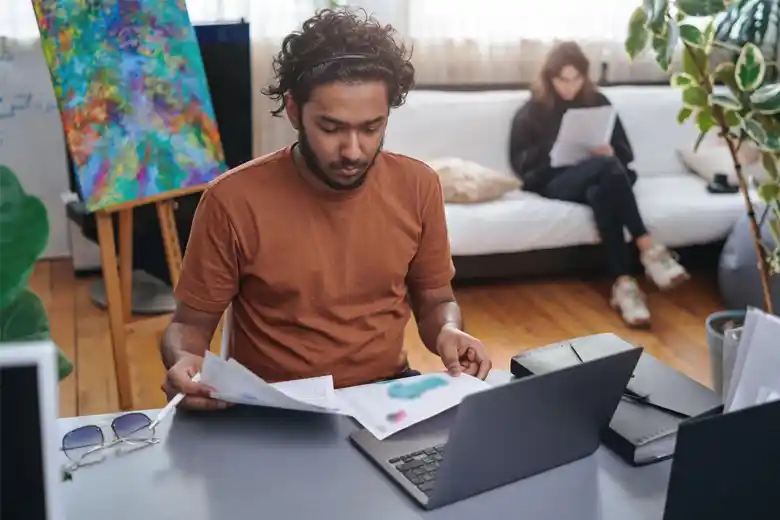
6. Taking the next step in your graphic design career
With a successful graphic design internship on your resume, you’ll be one step closer to landing a full-time role in the field.
As your internship draws to an end, consider what kinds of jobs you’d like to apply for next and how your internship has prepared you for such roles. Reflect on what you’ve learned and how you’ve grown as a graphic designer—and think about how you can communicate that to prospective employers.
What did you gain from your internship and how will that be valuable for your next employer? What new skills did you learn that you’ll carry with you into your next role?
A graphic design internship can be an incredibly rich and transformative experience. Make sure you demonstrate the value of your internship and use it to take the next step in your career.
If you’d like more advice on breaking into the industry, continue with this guide: How To Become a Graphic Designer and Navigate the Job Market.
Next steps
Are you new to graphic design and keen to learn more about this fascinating field? Here’s what you can do next:
- Watch this session by design veteran and AND’s Academic Head, Prachi Mittal, and our Course Lead, Soumya Tiwari.
- Talk to a course advisor to discuss how you can transform your career with one of our courses.
- Pursue our Graphic Design courses – all courses are taught through live, interactive classes by industry experts, and some even offer a Job Guarantee.
- Take advantage of the scholarship and funding options that come with our courses to overcome any financial hurdle on the path of your career transformation.
Note: All information and/or data from external sources is believed to be accurate as of the date of publication.




